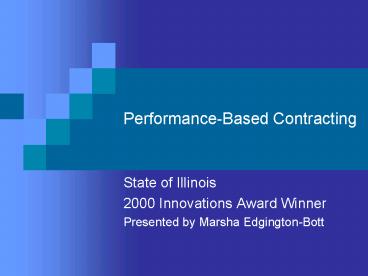PerformanceBased Contracting - PowerPoint PPT Presentation
1 / 19
Title:
PerformanceBased Contracting
Description:
Presented by Marsha Edgington-Bott 'Permanency' Every child deserves a stable and lasting family life. ... This basic principle of 'permanency,' endorsed as far ... – PowerPoint PPT presentation
Number of Views:70
Avg rating:3.0/5.0
Title: PerformanceBased Contracting
1
Performance-Based Contracting
- State of Illinois
- 2000 Innovations Award Winner
- Presented by Marsha Edgington-Bott
2
Permanency
- Every child deserves a stable and lasting family
life. This basic principle of permanency,
endorsed as far back as the 1909 White House
Conference on the Care of the Dependent Child,
has been a goal of public child welfare systems
for most of this century.
3
Illinois Performance Contracting
- Introduced in 1997
- Since that time performance contracting has been
critical in moving Illinois from one of the
nations lowest-performing child welfare systems
in moving children to permanency to a national
leader
4
Crisis in Permanency - Nationwide
- Foster care caseloads rose nationwide from
280,000 children in 1986 to 502,000 children in
1996. - There were 6.9 foster children for every 1,000
children. - This was the highest prevalence rated recorded
this century.
5
Illinois Crisis
- There were 17.1 foster children for every 1,000
- This was the highest prevalence rate in the
nation. - Foster care growth was eating up more than its
share of state revenues - Workloads of 50 to 60 children per caseworker
- Illinois substitute care system should have been
half its actual size in 1997 - Median length of time entering children stayed in
care had increased from 8 months in 1986 to 56
months in 1996
6
Investing in Permanency
- The rate of children exiting the system fell
below the rate of new cases coming in
system-wide. - Part of the problem was the basic contracting
structure. - Contracts based on a fee-for-child payment were
undermining permanency because once the child is
ready for permanency, an agency faces losing
revenue unless the child is replaced with a new
referral.
7
Performance Contracts in Illinois
- Significant investments in activity that would
support permanency - Focused staff positions
- Resources enabling providers to begin serving
children more quickly upon placement - More resources for support of children returning
to their biological parents - Administrative funds to support different models
of child welfare service provision
8
Contract Realignment
- The contract realigned financial incentives to
secure accountability and reinforce the
importance of achieving outcomes over maintaining
children in care. - Agencies were allowed to use superior performance
in moving children to permanency as a way of
lowering their caseloads, maintaining their
contract level and financially enhancing their
program.
9
Agency Redesign
- Redesign of how agencies receive new cases for
placement services - All agencies were required to accept 24 of their
caseload in new referrals - All agencies were expected to move 24 of their
caseloads to permanency - By exceeding the 24 benchmark an agency could
secure caseload reductions without loss of
revenue. - Falling short of the benchmark meant serving more
children without a change in contract level
10
Measures of Success
- The rise in adoptions
- The rise in subsidized guardianships
- The rise in overall agency performance levels
since the programs implementation.
11
Adoptions
- During fiscal year 1999, more children were moved
to adoption than in the combined years of
1987-1994. - Fiscal year 1997 adoptions 2,229
- Fiscal year 1998 adoptions 4,293
- Fiscal year 1999 adoptions 7,315
- Fiscal year 2000 adoptions 6,200
12
Subsidized Guardianship
- A new permanency option through Title IV-E waiver
from the federal government - Designed to create a permanency option for
relatives committed to the long-term care of
children placed in kinship care - Fiscal year 1998 1,276 children placed
- Fiscal year 1999 2,199 children placed
- Fiscal year 2000 1,700 children placed
13
Prior to Performance Contracting Initiative
- Average permanency rate for agencies placing
children in relative care was 6.7. - End of fiscal year 1998 averaged 20 with the
best agencies achieving 44. - End of fiscal year 1999 system-wide performance
for relative care climbed from 20 to 30. - End of fiscal year 2000 system-wide performance
for relative care climbed to 34.
14
Traditional Foster Care Permanency
- In 1998 performance contracting was expanded to
traditional foster care. - Fiscal year 1999 permanency rate climbed from
14 to 24 - Fiscal year 2000 permanency rate climbed to 25
15
Impact of Performance Contracting
- Caseload decline a 40 decline from 51,000
children in care to nearly 30,000 in just three
years - The reinvestment made possible through consistent
gains in permanency - Reinvestments support better service delivery for
the children and families in Illinois child
welfare programs - The savings generated by the declining caseloads
are used to fund contracted caseload reductions
20 by the year 2000
16
Sharing the Lessons
- The structure of performance contracts allows
capacity to be easily transferred from the worst
performing agencies to the best performing
agencies without additional cost. - Lowering caseloads is the way to reinvestment in
the future of children.
17
The Groundwork
- The state laws of Illinois had to be changed so
that undo hesitancy about terminating parental
rights was removed as a barrier in adoption. - In 1997 Illinois passed the Permanency
Initiative, which eliminated long term foster
care as a permanency goal, reduced the timelines
to one-year, and directed the Dept. to engage in
concurrent planning to help achieve permanency at
the earliest opportunity.
18
More on Groundwork
- Partnerships with the Courts specific judges
took the lead establishing the legal groundwork
for moving Illinois wards into permanent homes. - The Dept. supported real partnership with
private service providers which emphasized
sharing information on system performance,
barriers to improving and dealing with the
ongoing challenges inherent in serving a
vulnerable population.
19
Since 2000































